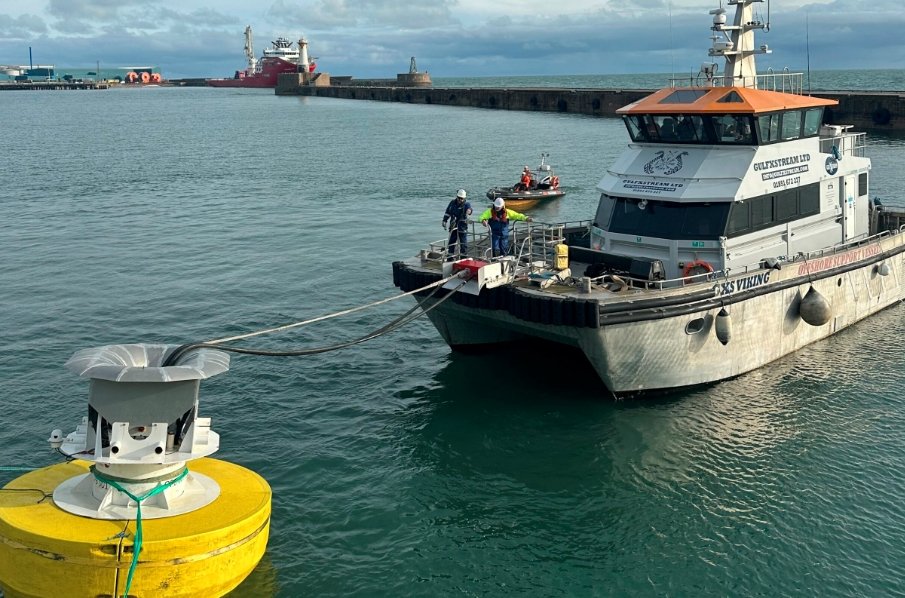Scotland may have just pulled off one of the most ambitious energy pivots the world has ever seen. Not by digging deeper or building taller—but by letting the ocean do the work.
A Glasgow-based company, Oasis Marine, is turning heads with a fleet of futuristic buoys that may rewrite the rules of shipping. If successful, this floating hydrogen station concept could signal the beginning of the end for diesel-powered vessels.
A New Route for Clean Shipping Power
The shipping industry has long been the elephant in the climate room. It’s essential, but it’s filthy.
Roughly 90% of the world’s goods move by sea. Yet international shipping pumps out nearly 1 billion tons of CO₂ annually—about 13% of the global transport sector’s total emissions. Everyone knows it, but few have figured out how to fix it.
Electric cargo ships? Not yet practical. Massive onboard batteries don’t play well with long-haul voyages.
Hydrogen-powered vessels? That’s been the dream. But until now, clean hydrogen’s been too expensive, hard to store, and near-impossible to deliver offshore. Oasis Marine thinks they’ve cracked it.

What Exactly Is This “Underwater Treasure”?
Well, it’s not treasure in the Pirates of the Caribbean sense. No sunken chests or gold doubloons.
The real prize is clean, storable, and scalable hydrogen.
Oasis Marine’s innovation is simple in concept but sophisticated in execution. Picture this: a network of floating buoys, each one loaded with solar panels, wind turbines, and a compact electrolyzer. These devices use seawater—yes, seawater—and electricity from the elements to produce hydrogen gas.
Stored in pressurized tanks onboard the buoy, that gas is then ready to be pumped into ships passing by. No dock required.
It’s essentially a floating gas station in the middle of the sea—except it’s clean, renewable, and decentralized.
Tested in Glasgow, Built for Global Waters
The prototype was put through its paces at the Kelvin Hydrodynamic Lab in Glasgow, one of the world’s top facilities for marine testing.
It passed.
More importantly, it’s been certified for deployment—meaning these buoys could start popping up along shipping routes sooner than expected.
• The refueling process is designed to be fast and easy. Ships simply dock briefly at a buoy and receive hydrogen like they would diesel.
• Safety systems onboard the buoys include high-pressure regulators and remote sensors.
• The buoys are built to survive extreme conditions—storms, high seas, and salt corrosion.
That last point matters. Offshore environments are brutal. But Oasis says their design can hold up for years, cutting down on maintenance and downtime.
Why This Could Work Better Than Ammonia or Batteries
So why not just go with ammonia? Or batteries?
Ammonia has been considered a potential carrier for hydrogen. It’s more stable and easier to store. But it’s also toxic and requires energy to convert back into usable hydrogen onboard ships. That conversion step adds cost and risk.
Batteries, meanwhile, are ideal for ferries or short-range trips. But long-haul freight? Forget it. The weight alone makes it unfeasible.
Here’s where the Oasis model shines. It allows ships to refuel hydrogen mid-journey, using a product made from seawater and renewable energy.
And it skips the messy conversions.
A Look at the Potential Reach of Floating Hydrogen
The concept isn’t just good in theory. It actually scales well.
Here’s a breakdown of how Oasis hydrogen buoys stack up compared to traditional marine fuels:
| Metric | Diesel Fuel Ships | Ammonia-Based Systems | Oasis Hydrogen Buoys |
|---|---|---|---|
| CO₂ Emissions | Very High | Lower (with caveats) | Zero |
| Storage Safety | Moderate | Hazardous | Safe with built-in systems |
| Refueling Accessibility | Port only | Limited infrastructure | Offshore, mid-route |
| Fuel Conversion Required | No | Yes | No |
| Production Feedstock | Crude oil | Hydrogen + nitrogen | Seawater + wind/solar |
Oasis buoys are built for more than just marine use.
They could plug into floating offshore wind farms, acting as mobile energy hubs. In areas without stable energy grids, they might even serve remote islands, oil rigs, or coastal communities.
One sentence here, just to keep it human.
That sort of flexibility is rare. Especially in green tech.
More importantly, the buoys help solve the problem of transporting green hydrogen—a major barrier to scaling clean energy globally. Instead of building miles of hydrogen pipelines or retrofitting every port, why not float the fuel where it’s needed?
Scotland’s Bet on Hydrogen Is Bolder Than It Looks
It’s easy to miss what’s happening here. The Oasis Hydrogen Buoy might look like another science lab gadget. But it’s not.
It’s a working, certified, renewable energy system with global relevance.
Hydrogen isn’t some fantasy fuel anymore. It’s already powering trains in Germany, buses in South Korea, and industrial plants in Japan. The real struggle has been delivering it safely and cheaply, especially to moving targets like ships.
That’s what Oasis has tackled head-on. And they’ve done it from the waters of Scotland.
The Bigger Picture: Green Hydrogen Is Growing Up
Green hydrogen used to be the darling of climate conferences. Everyone talked about it. Few built anything.
That’s changing.
Australia’s CSIRO has developed a powdered hydrogen product that makes shipping and storing the fuel dramatically easier. In Europe, HyDeploy has tested hydrogen blends in gas grids. In the U.S., Plug Power is building hydrogen hubs across multiple states.
And now this: a floating, zero-emissions marine fuel station with full certification.
It’s not hype. It’s happening.


















